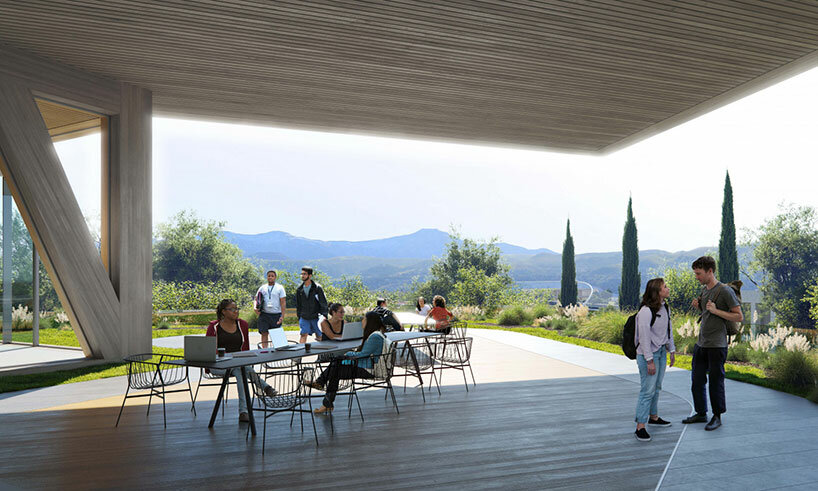BIG fosters dynamic interaction & transparency for new sciences center in california
BIG’s Sciences Center at California’s Claremont McKenna College
BIG (Bjarke Ingels Group) has revealed renders for its new Robert Day Sciences Center, currently under construction, at California‘s Claremont McKenna College. Occupying almost 12,000 sqm (135,000 sq ft), the project takes form as a pile of rectangular volumes, rising in pairs that rotate 45 degrees on its second and third levels. This arrangement creates a soaring central atrium that fosters transparent and dynamic interaction between the different levels and disciplines. A wooden triangulated truss runs along each volume, generating a vivacious connection with glass resulting in a striking facade. Through the generous amount of glazing that embraces the structure, not only the boundaries between the facilities but also between the built space and public space are slightly obscured, forcing a more intimate inter-disciplinary collaboration. all images BIG (Bjarke Ingels Group)
all images BIG (Bjarke Ingels Group)
optimizing integration & interaction
Designed by renowned architects BIG (Bjarke Ingels Group), the Robert Day Sciences Center ushers in a new phase for Claremont McKenna College. The project will house ‘the College’s next-generation Kravis Department of Integrated Sciences, a powerful, multi-disciplinary, computational approach to advancing gene, brain, and climate knowledge’. Each level of the building is completely glazed and clad with timber trusses. Emerging as a pair of blocks, a sky-lit ‘social hub’ unveils at its core, ‘allowing life to seamlessly flow between the inside and outside while encouraging inter-disciplinary collaboration’.
‘More than ever, we are seeing the confluence of previously distinct disciplines: breakthroughs in computer and data science lead to breakthroughs in the natural and life sciences. As a consequence, we need to provide spaces for the integration of these previously siloed sciences. The architecture for the new Robert Day Sciences Center’s seeks to maximize this integration and interaction. The labs and classrooms are stacked in a Jenga-like composition framing a column-free, open internal space with the freedom and flexibility to adapt the ever-evolving demands of technology and science. It is our hope that the building will not only provoke new conversations between scientists but that it may also stimulate the rest of the liberal arts students to take a deeper interest in the sciences and vice versa. The analytical embracing the experimental – rationality intersecting with creativity,’ says Bjarke Ingels, Founder, BIG.
The entrance of the building creates a stunning protruding angular form composed at the conjunction of the two levels. Walking through, a grand staircase unfolds, guiding to the upper levels. The structure accommodates a series of eight outdoor rooftop terraces that can double as social spots or open-air classroom expansions with sweeping views of the natural surroundings.
 each level takes form as two glazed parallel volumes
each level takes form as two glazed parallel volumes the glass volumes are outlined by zig-zag wooden trusses
the glass volumes are outlined by zig-zag wooden trusses the structure fosters interaction between different levels and disciplinaries
the structure fosters interaction between different levels and disciplinaries a soaring, sky-lite central atrium dominates the interior
a soaring, sky-lite central atrium dominates the interior
spacious terraces double as study spaces with wide views of the surroundings

blurring the boundaries between build space and nature

